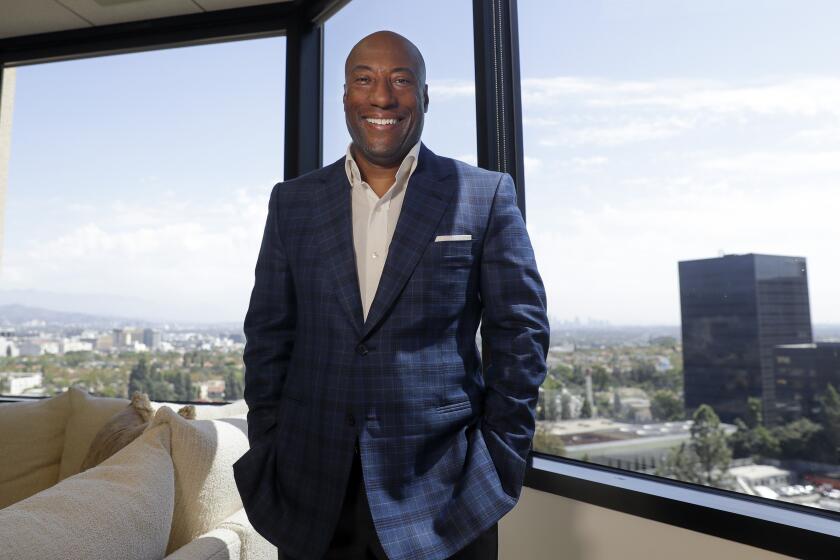Good Grief, It’s a Comedy
- Share via
Meet Grandma Sylvia’s family. It’s not a pretty bunch.
There’s performance artist skyBoy (formerly known as Stewart) in red-tinted sunglasses and Reebok sneakers; gum-chomping Marlena, who totes Evian bottled water and a Gucci bag; Jerry, in patent-leather white shoes and a jungle-print shirt; Elsie, in a puffy vest resembling an ostrich dipped in lame and toilet paper dangling from her shoe; sobbing Melissa playing a tuneful Hatikvah on her violin; grandstanding Gary taking the opportunity to belt out a chorus of “My Yiddishe Mama,” and Dori, in fishnets and skintight mini-dress, reading her tribute: “God couldn’t be everywhere, so he invented grandmas.”
They’re all part of the fun at “Grandma Sylvia’s Funeral,” an interactive comedy that marked its 18th month last week at the Hudson BackStage in Hollywood.
The 23-character piece follows in the tradition of such participatory theater works as “Tony ‘n’ Tina’s Wedding” and “Barry Moses’ Bar Mitzvah,” with cast members segueing from their scripted dialogue for impromptu chatter with theatergoers.
Audiences meet the colorful, bickering “family” as it lines up to enter the Helsenrott Mortuary, last resting place of Sylvia Schildner Grossman.
The show is the brainchild of actors Glenn Wein and Amy Lord, who were longtime cast members in the New York company of “Tony ‘n’ Tina’s Wedding,” which poked fun at the raucous nuptials of a young Italian American couple.
“Amy and I went to lunch one day and decided to create an environmental show for Jewish audiences,” said Wein, who also directs “Grandma Sylvia” and plays grandson Gary. Some time later, when they were both in Los Angeles--and both their grandmothers and many friends had died--they got together and plotted an outline.
“We needed an outlet to express our grief, but in a comical, entertaining way,” Wein continued. “We knew the parts of ‘Tony ‘n’ Tina’ that worked, the parts that were underdeveloped. What audiences liked most was the opportunity for intimacy.”
Solemnity, however, is hardly the order of the day. From the creepy mortuary greeter (who stamps entrance passes with a Batman design and hisses to himself, “I hated the old lady”) to Rachel (that’s doctor Rachel), who offers an airy lecture on dysfunction and denial, the memorial service and reception are high on humor, low on philosophy. For energetic theatergoers, there’s a chance to hit the dance floor with one of the chatty cast members. For hungry audience members, there is a well-stocked buffet.
Ethnicity is a strong component of the piece. The Yiddish flies fast and furious.
“Being Jewish and doing a Jewish show,” said Wein, “we wanted a broad base of characters: wealthy Jews, poor Jews, assimilated Jews, the discarded first wives--and the flashier, easier models that replaced them. In other words, we wanted to make some political points, and let the characters tell the story.”
The initial cast was assembled by Wein and Lord with friends and people whose work they’d seen. The script was created through a series of workshops, brainstorming and storytelling among the group. Many of the characters hit close to home.
“The truth is, some are based on real people, some are composites,” said Wein, who acknowledges his own mother was one of the “abandoned first wives.”
One of the most striking visual aspects of the show is the age range of its audiences.
“We’ve had very old, very sick people to the show,” Wein said, “and they have a good time. I think it’s been successful because it doesn’t offend anyone. We’ve had Hasidim--which surprised me because the show is so irreverent, a lot of black people, a whole party of Koreans. We have everything. You never know what you’re going to get in the audience, which is great.”
More to Read
The biggest entertainment stories
Get our big stories about Hollywood, film, television, music, arts, culture and more right in your inbox as soon as they publish.
You may occasionally receive promotional content from the Los Angeles Times.










